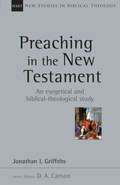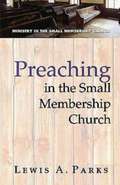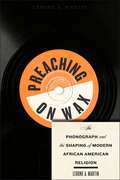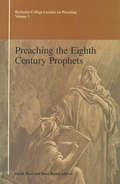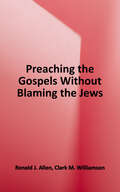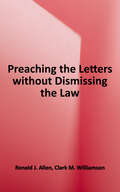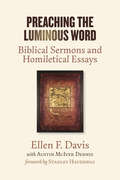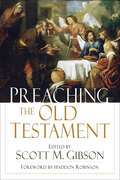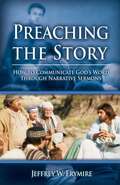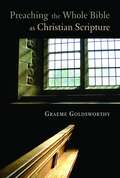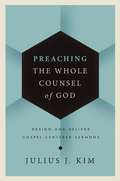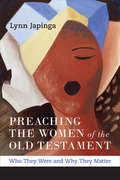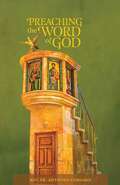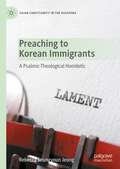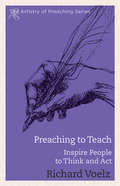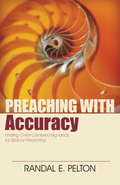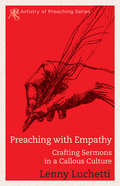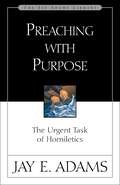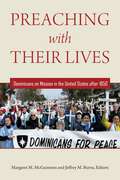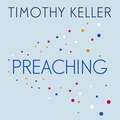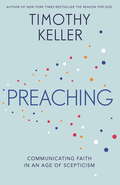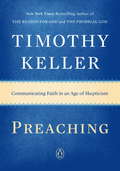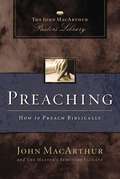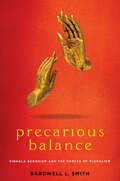- Table View
- List View
Preaching in the New Testament (New Studies in Biblical Theology #Volume 42)
by Jonathan GriffithsMany Christians share the assumption that preaching the word of God is at the heart of God's plans for the gospel in our age, that it is vital for the church's health, and that it is the central task of the pastor-teacher. Many helpful books on preaching are available. The vast majority are concerned with "how-to," but relatively few focus primarily on the character and theology of preaching according to Scripture. Two key, interrelated questions need to be addressed. First, is there such a thing as "preaching" that is mandated in the post-apostolic context—and, if there is, how is it defined and characterized? Second, how does post-apostolic "preaching" relate to the preaching of the Old Testament prophets and of Jesus and his apostles? In this New Studies in Biblical Theology volume Jonathan Griffiths seeks answers to these questions in the New Testament. In Part One he gives an overview of the theology of the Word of God, surveys Greek terms related to preaching, and looks at teaching concerning the scope and character of other word ministries in the life of the church. In Part Two his exegetical studies concentrate on teaching that relates especially to the post-apostolic context. In Part Three he summarizes the exegetical findings, sets them within the context of biblical theology, and proposes a number of broader theological implications. Griffiths's accessible, scholarly investigation will be of value to scholars, pastors, preachers, and Bible teachers. Addressing key issues in biblical theology, the works comprising New Studies in Biblical Theology are creative attempts to help Christians better understand their Bibles. The NSBT series is edited by D. A. Carson, aiming to simultaneously instruct and to edify, to interact with current scholarship, and to point the way ahead.
Preaching in the Small Membership Church (Small Membership Church)
by Lewis A. ParksStep into the pulpit in a small membership church, and you’ll sometimes find your fair share of challenges, but you’ll almost always find more than your share of blessings as well. Those blessings, and the chance for authentic, life-transforming preaching, are what preaching in the small membership church are all about. Lewis Parks knows those blessings well. For nearly 40 years he has preached in small membership churches and taught others who serve in them. In this book he lays out the distinct roles that preaching in the small membership church calls on us to fill, and offers down-to-earth, substantive guidance on how to be the best preacher you can be in these most numerous, and most important, outposts of Christ’s church.
Preaching on Wax: The Phonograph and the Shaping of Modern African American Religion (Religion, Race, and Ethnicity #5)
by Lerone A MartinThe overlooked African American religious history of the phonograph industry Winner of the 2015 Frank S. and Elizabeth D. Brewer Prize for outstanding scholarship in church history by a first-time author presented by the American Society of Church History Certificate of Merit, 2015 Award for Excellence in Historical Recorded Sound Research presented by the Association for Recorded Sound CollectionsFrom 1925 to 1941, approximately one hundred African American clergymen teamed up with leading record labels such as Columbia, Paramount, Victor-RCA to record and sell their sermons on wax. While white clerics of the era, such as Aimee Semple McPherson and Charles Fuller, became religious entrepreneurs and celebrities through their pioneering use of radio, black clergy were largely marginalized from radio. Instead, they relied on other means to get their message out, teaming up with corporate titans of the phonograph industry to package and distribute their old-time gospel messages across the country. Their nationally marketed folk sermons received an enthusiastic welcome by consumers, at times even outselling top billing jazz and blues artists such as Bessie Smith and Ma Rainey.These phonograph preachers significantly shaped the development of black religion during the interwar period, playing a crucial role in establishing the contemporary religious practices of commodification, broadcasting, and celebrity. Yet, the fame and reach of these nationwide media ministries came at a price, as phonograph preachers became subject to the principles of corporate America. In Preaching on Wax, Lerone A. Martin offers the first full-length account of the oft-overlooked religious history of the phonograph industry. He explains why a critical mass of African American ministers teamed up with the major phonograph labels of the day, how and why black consumers eagerly purchased their religious records, and how this phonograph religion significantly contributed to the shaping of modern African American Christianity. Instructor's Guide
Preaching the Eighth Century Prophets: Preaching The 8th Century Prophets
by David Fleer Dave BlandIn short, we hope that this volume will provide an appropriate model for the hungry preacher and hopeful congregation who search for the passionate realities found within the worlds revealed in Scripture...The worlds of the Bible are the places where we are understood for our true selves, where we can discern our meaning and are encouraged to live above the mundane self-absorbed. May this volume help transport the listener into a realm where he or she may be fashioned by the God who promises to recreate us all.- Excerpts from the editor's Introduction
Preaching the Gospels Without Blaming the Jews
by Ronald J. Allen Clark M. WilliamsonThe authors provide a commentary on the Revised Common Lectionary Gospel readings, demonstrating how the lections are continuous with the theology, values, and practices of Judaism and also identifying and reflecting on points at which the lections caricature Jewish people, practices, and institutions.
Preaching the Letters Without Dismissing the Law: A Lectionary Commentary
by Ronald J. Allen Clark M. WilliamsonThis unique commentary helps preachers see how knowledge of first-century Judaism can help them avoid incorporating misunderstandings and stereotypes into their sermons on the letters. The authors explore insights from recent Christian-Jewish dialogue, continuities between Judaism and the theology of Paul, and the Roman occupation to help preachers understand the Jewish context of the letters. <p><p>As in their previous book, Preaching the Gospels without Blaming the Jews, they also suggest how today's preacher can deal with issues or comments in the text that are inappropriate or controversial in today's context.
Preaching the Luminous Word: Biblical Sermons and Homiletical Essays
by Ellen F. Davis Austin McIver DennisInsights from one of the most distinctive and eloquent scholar-preachers of our time Inviting serious theological engagement with texts from all parts of the Christian Bible, Preaching the Luminous Word is a collection of fifty-one sermons and five related essays from noted preacher and biblical scholar Ellen F. Davis. A brief preface to each sermon delineates its liturgical context and theological themes as well as distinctive elements of structure and style. Arranged in canonical order, the sermons treat a wide range of texts: Torah, Prophets, Writings, Gospels, Epistles, and Revelation. They are complemented by essays on various aspects of biblical interpretation for preaching. At once accessible, theologically informed, and rhetorically rich, this volume will engage preachers, teachers, seminarians, church leaders, and serious lay readers.
Preaching the Luminous Word: Biblical Sermons and Homiletical Essays
by Ellen F. Davis Austin McIver DennisInsights from one of the most distinctive and eloquent scholar-preachers of our time Inviting serious theological engagement with texts from all parts of the Christian Bible, Preaching the Luminous Word is a collection of fifty-one sermons and five related essays from noted preacher and biblical scholar Ellen F. Davis. A brief preface to each sermon delineates its liturgical context and theological themes as well as distinctive elements of structure and style. Arranged in canonical order, the sermons treat a wide range of texts: Torah, Prophets, Writings, Gospels, Epistles, and Revelation. They are complemented by essays on various aspects of biblical interpretation for preaching. At once accessible, theologically informed, and rhetorically rich, this volume will engage preachers, teachers, seminarians, church leaders, and serious lay readers.
Preaching the Old Testament
by Scott M. GibsonPreaching the Old Testament equips pastors to journey into the forest and find a passion and confidence for preaching on the Old Testament.
Preaching the Story: How to Communicate God's Word Through Narrative Sermons
by Jeffrey W. FrymirePreaching the Story explores why communication is more effective when sermons are no longer lectures but stories. It explains how to deliver your entire sermon in story form. A practical book for pastors and ministerial students.
Preaching the Whole Bible as Christian Scripture: The Application of Biblical Theology to Expository Preaching
by Graeme GoldsworthyWhile strong, gospel-centered preaching abounds, many Christian pastors and lay preachers find it difficult to preach meaningfully from the Old Testament. This practical handbook offers help. Graeme Goldsworthy teaches the basics of preaching the whole Bible in a consistently Christ-centered way.Goldsworthy first examines the Bible, biblical theology, and preaching and shows how they relate in the preparation of Christ-centered sermons. He then applies the biblical-theological method to the various types of literature found in the Bible, drawing out their contributions to expository preaching focused on the person and work of Christ.Clear, complete, and immediately applicable, this volume will become a fundamental text for teachers, pastors, and students preparing for ministry.
Preaching the Whole Counsel of God: Design and Deliver Gospel-Centered Sermons
by Michael Horton Julius KimPreaching the Whole Counsel of God is a primary textbook on the art and science of preaching for pastors and pastors-in-training that teaches you how to practice expository, Christ-focused hermeneutics, combined with Gospel-centered, audience-transforming homiletics. It will guide you to: Discover the truth of the text according to the human author. Discern Christ in the text according to the divine author. Design your sermon with truth, goodness, and beauty. Deliver your sermon in a way that keeps attention, retention, and leads to transformation.
Preaching the Women of the Old Testament: Who They Were And Why They Matter
by Lynn JapingaTake an in-depth look at over twenty fierce, faithful, and strong women featured in the Old Testament with Preaching the Women of the Old Testament. Inside this unique resource author Lynn Japinga interprets the stories of various biblical women, including Eve, Rebekah, Dinah, Tamar, Miriam, Deborah, Jael, Abigail, Bathsheba, and Vashti. Along with providing an interpretation, Japinga demonstrates how the character's story has been read in Christian tradition and offers sermon ideas that connect contemporary issues to each story. This book is ideal for pastors who want to know more about the many women of the Old Testament and learn how to better incorporate them into their sermons.
Preaching the Word of God (The Saint John Chrysostom Lectures on Preaching)
by Anthony M. ConiarisFather Anthony Coniaris, a priest of the Greek Orthodox Church, an outstanding preacher of deep faith, and a prolific author, was invited to give the third annual Saint Chrysostom Lectures on Preaching. In place of the three lectures given at Holy Cross, Father Coniaris generously offered Holy Cross Press an entire volume entitled: Preaching the Word of God. Although directed primarily to those who preach or wish to preach the word of God, the present volume offers much more in terms of spiritual nourishment to all Christians. It is in fact a book that can be read with great profit by everyone interested in a living faith.
Preaching to Korean Immigrants: A Psalmic-Theological Homiletic (Asian Christianity in the Diaspora)
by Rebecca Seungyoun JeongIn terms of practical-theology’s critical reflection on marginalized people’s wounds in a wider society, this book investigates the question, “How to proclaim the good news in response to first-generation Korean immigrants’ contextual suffering in the United Sates?” To answer the question, the book starts with investigating Korean immigrant hearers’ contextual predicaments in a new land to point out emerging practical-theological issues in relation to the practice of preaching. In this book, the primary subjects are first-generation Korean immigrants, especially those who have relatively low socio-economic status and struggle with the purpose of their lives as immigrants, particularly those whose material dreams have been shattered.In order to proclaim the good news, this book proposes a more appropriate immigrant theology for/in the practice of preaching by reclaiming the priorities of God’s future in our lives and confirming God’s active identification with Korean immigrant congregations in the depths of their predicament. Such reconstructive work for immigrant theology arises in response to their existential hardships, marginality, ethnic discrimination, and relative powerlessness in life.While acknowledging both the possibilities and limits of the diverse forms of current Korean immigrant preaching, the book then offers a strategic proposal for a new homiletic theory, namely “a psalmic-theological homiletic.” This proposed homiletic is deeply rooted in the theology of the Psalms and their rhetorical movement. This re-envisioned mode of eschatological and prophetic preaching in times of difficulty recovers ancient Israel’s psalmic, rhetorical tradition that aims toward faith. Its theological-rhetorical strategy intends to both transform hearers’ habitus of living in faith and enhance their hope-filled life through communal anticipation of God’s coming future on the margins. Specifically, this proposed homiletic critically adopts key features from psalms of lament and their typical, fourfold theological-rhetorical movement (i.e., lament, retelling a story, confessional doxology, and obedient vow) as now core elements of a revised Korean-immigrant preaching practice.
Preaching to Teach: Inspire People to Think and Act
by Richard VoelzPreaching to Teach merges the related functions of preaching and teaching, and equips the reader to accomplish both. Preachers stand up to speak each week in challenging times to unsettled congregations. Each week seems to bring a new difficult subject: mass shootings and other forms of violence; hard conversations around race, ethnicity, and multi-religious contexts; immigration; poverty; climate change; foreign and domestic terrorism; and bickering about it all on social media. Preachers are hungry for ways to envision the work of preaching in these times, as well as for tools that will help them speak to difficult and contentious topics. In a divided and weary world, preachers struggle with the choice of any number of "images" to describe their preaching identity. Responding to social crisis after social crisis, preachers most often lean toward the roles of pastor, prophet, or somewhere on the spectrum in between the two. Juggling between these images and their associated roles on a week-to-week basis can be exhausting. But there is an ancient image of the preacher that may help: the preacher as teacher. The image of teacher has traditionally focused on content and rhetorical aspects of preaching: the preacher is conveying information, modeling theological reasoning, or effecting a certain pulpit style. But rather than focusing on traditional concepts of teaching to determine the content, form, style, or delivery of sermons, the field of critical pedagogy (represented by notable figures such as Paulo Freire, Henry Giroux, Peter McLaren, and bell hooks) offers a way of re-envisioning the preacher-as-teacher. Recasting the preacher-as-teacher through the lens of critical pedagogy grounds the image of teacher in an ethical framework, inviting preachers to redefine their public roles, stand in relationships of solidarity with communities of faith, break the silences of taboos, tackle tough issues, and re-imagine the world in the shape of the kingdom of God.
Preaching with Accuracy: Finding Christ-Centered Big Ideas for Biblical Preaching
by Randal E. PeltonA resource to help pastors correctly identify the big idea of a passage and apply it wellPreaching with Accuracy provides preachers with a method for finding the “big idea” in each passage of the Bible, since correctly identifying the main point is key to accurately conveying the essential theology of the passage.Pelton lays out a reliable, well-informed method for identifying the main point of a preaching passage and understanding that passage well in its context. Numerous examples are given at each step of the way to show how meaning develops throughout the process of interpretation. Pelton then guides the preacher through applying a Christ-centered hermeneutic that will result in biblical sermons that benefit and equip believers.
Preaching with Empathy: Crafting Sermons in a Callous Culture (Artistry of Preaching)
by Lenny LuchettiPreachers can find help from many resources to get the text right, the structure right, and the delivery right. Preaching with Empathy aims to help preachers and homiletics students learn to deeply understand and love their listeners, in order to get preaching right. Preachers who profess a love for God, Scripture, and preaching, but who lack loving empathy for the listener, betray their three professed loves and limit their fruitfulness in ministry. This book teaches how to practice preaching in new ways, incorporating a heightened awareness and empathy for the people in the preacher’s community. Author Lenny Luchetti provides immediately useful tools, all based on the foundations of scripture, theology, history, and social awareness. Readers will learn to embody Christ for their congregations, as they empathically love God and humanity.This book is part of the successful Artistry in Preaching series, edited by Paul Scott Wilson. Other books in the series include Preaching as Poetry: Beauty, Goodness and Truth in Every Sermon, by Paul Scott Wilson; Actuality: Real Life Stories for Sermons that Matter, by Scott Hoezee; and Preaching in Pictures: Using Images for Sermons that Connect, by Peter Jonker.
Preaching with Purpose: The Urgent Task of Homiletics
by Jay E. Adams"The amazing lack of concern for purpose among homileticians and preachers has spawned a brood of preachers who are dull, lifeless, abstract and impersonal; it has obscured truth, hindered joyous Christian living, destroyed dedication and initiative, and stifled service for Christ." –Jay Adams, from the book Preaching needs to become purposeful, says Jay Adams, because purposeless preaching is deadly. This book was written to help preachers and students discover the purpose of preaching has and the ways that the Scriptures inform and direct the preaching task. Preaching with Purpose, like the many other books of Jay Adams, speaks clearly and forcefully to the issue. Having read this book, both students and experienced preachers will be unable to ignore the urgent task of purposeful preaching. And the people of God will be the better for it.
Preaching with Their Lives: Dominicans on Mission in the United States after 1850
by Margaret M. McGuinness and Jeffrey M. BurnsThis volume tells the little-known story of the Dominican Family—priests, sisters, brothers, contemplative nuns, and lay people—and integrates it into the history of the United States. Starting after the Civil War, the book takes a thematic approach through twelve essays examining Dominican contributions to the making of the modern United States by exploring parish ministry, preaching, health care, education, social and economic justice, liturgical renewal and the arts, missionary outreach and contemplative prayer, ongoing internal formation and renewal, and models of sanctity. It charts the effects of the United States on Dominican life as well as the Dominican contribution to the larger U.S. history. When the country was engulfed by wave after wave of immigrants and cities experienced unchecked growth, Dominicans provided educational institutions; community, social, and religious centers; and health care and social services. When epidemic disease hit various locales, Dominicans responded with nursing care and spiritual sustenance. As the United States became more complex and social inequities appeared, Dominicans cried out for social and economic justice. Amidst the ugliness and social dislocation of modern society, Dominicans offered beauty through the liturgical arts, the fine arts, music, drama, and film, all designed to enrich the culture. Through it all, the Dominicans cultivated their own identity as well, undergoing regular self-examination and renewal.
Preaching: Communicating Faith in an Age of Scepticism
by Timothy KellerNew York pastor and acclaimed author Timothy Keller is widely known and respected for his compelling preaching, described by The New York Times as what has 'helped turn Dr Keller... into the pastor many call Manhattan's leading evangelist'. In this book he shares his wisdom on communicating the Christian faith from the pulpit as well as from the coffee shop. Most Christians - including pastors - struggle to talk about their faith in a way that applies the power of the Christian gospel to change people's lives. Timothy Keller is known for his insightful, down-to-earth sermons and talks that help people understand themselves, encounter Jesus and apply the Bible to their lives. In this accessible guide for pastors and laypeople alike, Keller helps readers learn to present the Christian message of grace in a more engaging, passionate and compassionate way.(P)2015 Penguin Audio
Preaching: Communicating Faith in an Age of Scepticism (The\gospel Coalition Ser.)
by Timothy Keller'It is an unexpected delight to read a book on preaching that makes you want to preach. Tim Keller has given us such a book... Here is an extremely readable book founded on sound scholarship... buy it. This is the most practical and inspirational book on preaching that I have read for years!' - The Methodist Recorder'In Preaching, Keller has made an invaluable contribution to the homiletic task. I would recommend that this book be placed in the hand of the preaching veteran and novice, and should be found in the homiletic section of all theological colleges.' - Christianity magazineNew York pastor and acclaimed author Timothy Keller is widely known and respected for his compelling preaching, described by The New York Times as what has 'helped turn Dr Keller... into the pastor many call Manhattan's leading evangelist'. In this book he shares his wisdom on communicating the Christian faith from the pulpit as well as from the coffee shop. Most Christians - including pastors - struggle to talk about their faith in a way that applies the power of the Christian gospel to change people's lives. Timothy Keller is known for his insightful, down-to-earth sermons and talks that help people understand themselves, encounter Jesus and apply the Bible to their lives. In this accessible guide for pastors and laypeople alike, Keller helps readers learn to present the Christian message of grace in a more engaging, passionate and compassionate way.
Preaching: Communicating Faith in an Age of Skepticism (The\gospel Coalition Ser.)
by Timothy KellerPastor, preacher, and New York Times bestselling author of The Songs of Jesus Timothy Keller shares his wisdom on communicating the Christian faith from the pulpit as well as from the coffee shop.Most Christians—including pastors—struggle to talk about their faith in a way that applies the power of the Christian gospel to change people’s lives. Timothy Keller is known for his insightful, down-to-earth sermons and talks that help people understand themselves, encounter Jesus, and apply the Bible to their lives. In this accessible guide for pastors and laypeople alike, Keller helps readers learn to present the Christian message of grace in a more engaging, passionate, and compassionate way.From the Hardcover edition.
Preaching: How to Preach Biblically (MacArthur Pastor's Library)
by John F. MacarthurJohn MacArthur and other distinguished teachers of preachers respond to the apostle's mandate in this comprehensive treatment of expository preaching. Dr. MacArthur's well-known passion for the Scriptures is combined with the vision and expertise of other faculty members at The Master's Seminary to produce a definitive statement on how to unfold the meaning of God's Word effectively to today's congregation.Other contributors include: James F. Stitzinger, James E. Rosscup, Robert L. Thomas, George J. Zemek, Donald G. McDougall, Richard L. Mayhue, Irvin A. Busenitz, and David C. Deuel.
Precarious Balance: Sinhala Buddhism and the Forces of Pluralism (Studies in Religion and Culture)
by Bardwell L. SmithSince the third century BCE, when the king of Sri Lanka converted to Buddhism, the island nation off the southern coast of India has represented a central interest of Buddhist scholarship. The association between its politics and religious life has not always remained harmonious, however, and has contributed to the contemporary turmoil that threatens to tear it apart. In this valuable book, renowned religious scholar Bardwell Smith elucidates the history of Buddhism in Sri Lanka from the time of one of its earliest rulers through to its present-day strife.The essays collected here for the first time explore various themes of Sri Lanka’s long history in novel and constructive ways. Topics include Sinhala Buddhists’ sense of manifest destiny arising from Sri Lanka’s oldest historical chronicles, the Mahavamsa and the Dipavamsa; the nationalist implications of the chronicles’ depiction of the third-century Mahavihara monastery as the site of "original Buddhism"; and concepts of order and legitimation of power in ancient Ceylon. With a new introduction and final chapter, Smith sheds fresh light on today’s Sri Lanka, connecting historical studies with contemporary issues.
